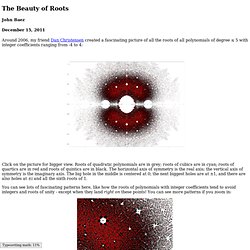

50 Free Open Courseware Classes About Every Type of Engineering. It may seem really easy to lump all engineering into one category.

However, the truth is that there are several different types of engineering. If you are interested in learning more about engineering, you can read about the different types of programs available. No matter your engineering degree, though, you can expect to earn a good salary, since engineers are in high demand. If you are interested in learning a little bit more about the world around you, and about engineering, here are 50 free open courseware classes that address different aspects of engineering. Mechanical Engineering This is a rather large field, mostly studying the mechanics of how things work. Chemical Engineering This type of engineering is about the way atoms and molecules interact. Real Analysis. Mathematics Courses. Roots. Typesetting math: 8% John Baez December 15, 2011 Around 2006, my friend Dan Christensen created a fascinating picture of all the roots of all polynomials of degree ≤ 5 with integer coefficients ranging from -4 to 4: Click on the picture for bigger view.

Roots of quadratic polynomials are in grey; roots of cubics are in cyan; roots of quartics are in red and roots of quintics are in black. You can see lots of fascinating patterns here, like how the roots of polynomials with integer coefficients tend to avoid integers and roots of unity - except when they land right on these points! Now you see beautiful feathers surrounding the blank area around the point 1 on the real axis, a hexagonal star around \exp(i \pi/ 3), a strange red curve from this point to 1, smaller stars around other points, and more.... People should study this sort of thing! Inspired by the pictures above, Sam Derbyshire decided to to make a high resolution plot of some roots of polynomials.
Infoverse - octomatics. Mathtools.net - Link Exchange for the Technical Computing Community. 13 Useful Math Cheat Sheets. Posted by Antonio Cangiano in Applied Math, Math Education, Software, Tutorial on September 20th, 2008 | 38 responses Cheat sheets can be very useful and make for great posters around your room.

The following is a collection of 13 cheat sheets for several mathematical topics and programs: And since most of us like to show our math pride off when out and about as well, Amazon sells this awesome Math Cheat Sheet T-shirt with formulas on both sides (Also available for Science and Engineering). How awesome is this? Sponsor’s message: Looking for online algebra homework solutions? Linear Algebra Video Lecture Course. Prime Time - Mathematicians have tried in vain to this day to discover some oreder inthe sequence of prime numbers... Online texts. Professor Jim Herod and I have written Multivariable Calculus ,a book which we and a few others have used here at Georgia Tech for two years.

We have also proposed that this be the first calculus course in the curriculum here, but that is another story.... Although it is still in print, Calculus,by Gilbert Strang is made available through MIT's OpenCourseWare electronic publishing initiative. Here is one that has also been used here at Georgia Tech. Linear Methods of Applied Mathematics, by Evans Harrell and James Herod.
Ask a Mathematician / Ask a Physicist. Physicist: We occasionally get questions about free learning resources.

Khan academy is excellent, and if you poke around you can find a smattering of free class notes and text books, but generally speaking the more more detailed/advanced the material, the more difficult it is to find/understand. In keeping with that tradition, here’s this ↓. It was originally written for a group of “mathlete” high school students to teach them number theory and erode their egos a bit. It’s Socratic, so rather than just presenting stuff to be known, it’s mostly a series of leading questions. Although number theory is a huge, horrifying field, what’s presented here is fairly accessible. If you notice any typos or omissions, or have questions or answers, put that mess in the comments, and if you happen to be a fair hand at LaTex and feel like constructing some solutions, I’ll post the hell out of that.
Could Knots Unravel Mysteries of Turbulent Fluid Flow? Spaghetti-thin shoelaces, sturdy hawsers, silk cravats — all are routinely tied in knots.

So too, physicists believe, are water, air and the liquid iron churning in Earth’s outer core. Knots twist and turn in the particle pathways of turbulent fluids, as stable in some cases as a sailor’s handiwork. For decades, scientists have suspected the rules governing these knots could offer clues for untangling turbulence — one of the last great unknowns of classical physics — but any order exhibited by the knots was lost in the surrounding chaos. Now, with deft new tools at their fingertips, physicists are beginning to master the art of tying knots in fluids and other flowable entities, such as electromagnetic fields, enabling controlled study of their behavior. “Now that we have these knots, we can measure the shape of them in 3-D; we can look at the flow field around them,” said William Irvine, a physicist at the University of Chicago. E-books. Logic Mazes. Ebooks Online Textbooks tutorials.